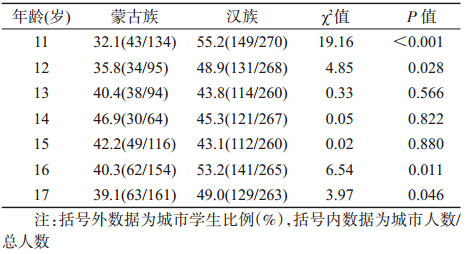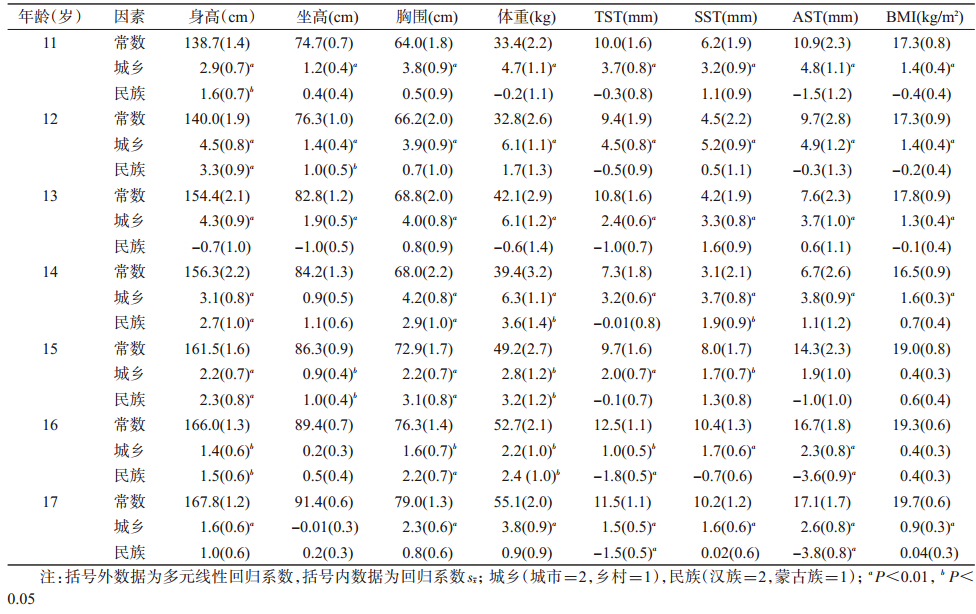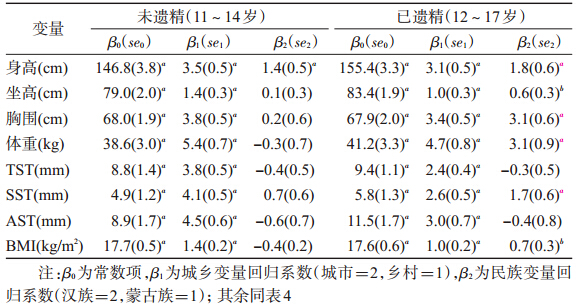文章信息
- 付连国, 孙丽丽, 阳益德, 李晓卉, 王烁, 孟祥坤, 王政和, 马军. 2015.
- Fu Lianguo, Sun Lili, Yang Yide, Li Xiaohui, Wang Shuo, Meng Xiangkun, Wang Zhenghe, Ma Jun. 2015.
- 蒙古族与汉族男生身体形态发育的差异分析
- Differences in anthropometric measurements between Mongolia boys and Han boys in China
- 中华流行病学杂志, 2015, 36(2): 167-171
- Chinese Journal of Epidemiology, 2015, 36(2): 167-171
- http://dx.doi.org/10.3760/cma.j.issn.0254-6450.2015.02.015
-
文章历史
- 投稿日期:2014-10-20
2. 蚌埠医学院人事处;
3. 北京大学医学部公共卫生学院 北京大学儿童青少年卫生研究所
2 Department of Human Resource, Bengbu Medical College;
3 School of Public Health and Institute of Child and Adolescent Health, Peking University
儿童青少年身体形态发育在遗传、地理及社会环境等因素的影响下,具有一定的民族特异性[1,2,3]。蒙古族是我国主要少数民族之一[4]。有研究显示,7~18岁蒙古族男生与汉族男生身体形态发育相近[3],已遗精者身体形态发育指标高于未遗精者[5],蒙古族男生首次遗精年龄晚于汉族男生[6]。本研究利用2010年全国学生体质与健康调研数据,按“是否遗精”分层分析蒙古族与汉族男生身体形态发育的差异。 资料与方法
1. 调查对象:资料来自2010年全国学生体质与健康调研数据,按性别、城乡进行分类(城男、乡男、城女、乡女),采用随机整群抽样法抽取学生(先确定调研学校,再以年级分层,以班级为整群)[7,8]。本研究从中选取内蒙古自治区11~17岁蒙古族和汉族男生调研数据,整理身高、体重、胸围、坐高、上臂部皮褶厚度(triceps skinfold thickness,TST)、肩胛部皮褶厚度(scapular skinfold thickness,SST)、腹部皮褶厚度(abdominal skinfold thickness,AST)、城乡及“是否遗精”指标,计算BMI;剔除不能回答“是否遗精”的研究对象,最终纳入2 671人,其中蒙古族为818人,汉族为1 853人。
2. 调查方法:根据《中国学生体质与健康调研细则》[9],对被调查学生进行身高、体重、胸围、坐高、TST、SST、AST指标测量,调查员均经过规范化培训,考核合格方可参与现场测量。身高、胸围、坐高均精确到0.1 cm,体重精确到0.1 kg,TST、SST、AST均精确到0.1 mm。“是否遗精”信息由内科医生面对面调查获得。
3. 统计学分析:采用SPSS 17.0软件进行统计学分析、构成比(%)的比较采用χ2检验,以“是否遗精”为因变量,城乡(城市=2,乡村=1)、民族(汉族=2,蒙古族=1)为自变量,进行多因素logistic回归分析,分析城乡、民族因素对“是否遗精”的影响。以各个身体形态发育指标为因变量,城乡(城市=2,乡村=1)、民族(汉族=2,蒙古族=1)为自变量,分别进行多元线性回归分析和多水平模型分析(个体为第1水平,年龄为第2水平),分析汉族与蒙古族学生身体形态发育指标的差异。 结 果
1. 基本情况:共调查男生2 671名,其中蒙古族818人(城市319人、农村499人),汉族1 853人(城市897人、农村956人)。11、12、16、17岁汉族城市学生比例分别为55.2%、48.9%、53.2%、49.0%,高于蒙古族男生的32.1%、35.8%、40.3%、39.1%(均P<0.05),见表 1。11、12、14岁蒙古族男生“已遗精”比例分别为0、3.2%、62.5%,汉族男生“已遗精”比例分别为8.1%、15.3%、76.0%,差异有统计学意义(均P<0.05),17岁蒙古族男生“已遗精”比例(99.4% )高于汉族男生(92.8%),差异有统计学意义(χ2=9.69,P=0.002),见表 2。
2. “是否遗精”的影响因素分析:以“是否遗精”(已遗精=1,未遗精=0)为因变量,城乡(城市=2,乡村=1)、民族(汉族=2,蒙古族=1)为自变量,进行多因素logistic回归分析。结果显示,12、14岁汉族男生发生“已遗精”的风险高于蒙古族男生,OR 值分别为5.55、1.90(均P<0.05),17岁汉族男生发生“已遗精”的风险低于蒙古族男生,OR=0.08(均P<0.05),见表 3。
3. 不同年龄蒙古族与汉族男生身体形态发育指标比较:按性别、年龄分层,各个身体形态发育指标作为因变量,城乡(城市=2,农村=1)、民族(汉族=2,蒙古族=1)作为自变量进行多元线性回归分析。结果显示,11~17岁男生的身高、胸围、体重、TST、SST,11~13、15岁男生的坐高,11~14、16、17岁男生的AST,11~14、17岁男生的BMI等指标为城市男生高于乡村男生(均P<0.05)。11、12、14~16岁男生的身高、12、15岁男生的坐高、14、15、16岁男生的胸围、体重、14岁男生的SST等指标均为汉族高于蒙古族(均P<0.05);16、17岁男生的TST、AST等指标为蒙古族高于汉族(均P<0.05);其他年龄组各指标在汉族男生与蒙古族男生间的差异无统计学意义(均P>0.05),见表 4。
4. 蒙古族与汉族青春期男生身体形态发育指标分层比较:蒙古族和汉族男生在11~15岁组“已遗精”较为集中,对这个年龄段按“是否遗精”分层,各个身体形态发育指标为因变量,城乡(城市=2,农村=1)、民族(汉族=2,蒙古族=1)为自变量进行多元线性回归分析。结果显示,在“未遗精”(11~14岁)男生中,除14岁男生坐高外,其他年龄各身体形态发育指标均为城市男生高于乡村男生(均P<0.05);11、12、14岁男生的身高为汉族高于蒙古族(均P<0.05),13岁男生的坐高、体重、BMI为蒙古族高于汉族(P<0.05)。在“已遗精”(12~15岁)男生中,除12岁男生的TST、BMI及13、15岁男生的AST、14岁男生的坐高、15岁男生的BMI等指标外,其他各年龄身体形态发育指标均为城市男生高于农村男生(P<0.05);12、15岁男生的身高、坐高及13、14、15岁男生的胸围,14、15岁男生的体重,14岁男生的SST等指标为汉族高于蒙古族(P<0.05),见表 5。
5. 蒙古族与汉族男生身体形态发育指标的平均差异:按“未遗精”(11~14岁)和“已遗精”(12~17岁)分层,各身体形态发育指标为因变量,城乡(城市=2,乡村=1)、民族(汉族=2,蒙古族=1)为自变量,进行多水平模型分析(个体为第1水平,年龄为第2水平)。结果显示,“未遗精”男生(11~14岁)身高、坐高、胸围、体重、TST、SST、AST、BMI等指标为城市男生分别高于乡村男生3.5 cm、1.4 cm、3.8 cm、5.4 kg、3.8 mm、4.1 mm、4.5 mm、1.4 kg/m2(均P<0.01),身高指标为汉族男生高于蒙古族男生1.4 cm(P<0.01),坐高、胸围、体重、TST、SST、AST、BMI等指标在两民族男生中的差异均无统计学意义(均P>0.05)。“已遗精”男生(12~17岁),身高、坐高、胸围、体重、TST、SST、AST、BMI等指标为城市男生高于乡村男生(3.1 cm、1.0 cm、3.4 cm、4.7 kg、2.4 mm、2.6 mm、3.0 mm、1.0 kg/m2,均P<0.01),身高、坐高、胸围、体重、SST、BMI指标为汉族男生高于蒙古族男生(1.8 cm、0.6 cm、3.1 cm、3.1 kg、1.7 mm、0.7 kg/m2,均P<0.05),TST、AST等指标在蒙古族男生与汉族男生中的差异均无统计学意义(均P>0.05),见表 6。
本研究显示,11、12、14岁蒙古族男生报告“已遗精”比例分别为0、3.2%、62.5%,低于汉族男生的8.1%、15.3%、76.0%,多因素logistic回归分析显示,12、14岁汉族男生发生遗精的风险高于蒙古族男生,OR值分别为5.55和1.90,提示汉族男生首次遗精年龄可能早于蒙古族,与宋逸等[6]研究结果相一致,可能与遗传因素及蒙古族儿童群居地区的经济水平普遍落后于当地汉族水平有关[8,10,11]。11、12、16、17岁汉族城市男生比例分别为55.2%、48.9%、53.2%、49.0%,均高于蒙古族男生,而且整体上两民族城市男生身体形态发育指标高于乡村男生,与已有研究结果一致[9,12]。提示在分析蒙古族与汉族学生身体形态发育指标的差异过程中“是否遗精”和“城乡”因素可能具有一定影响。
按“是否遗精”分层分析蒙古族男生与汉族男生身体形态发育指标的差异,结果显示,在13岁组,不按“是否遗精”进行分层分析,蒙古族男生与汉族男生身体形态发育指标差异无统计学意义;而按“是否遗精”进行分层分析,“未遗精”(11~14岁)男生的坐高、体重、BMI均为蒙古族高于汉族,“已遗精”男生的胸围为汉族高于蒙古族;在14岁组,不按“是否遗精”分层,汉族男生的身高、胸围、体重、SST均高于蒙古族,而分层后发现在“未遗精”男生仅身高这一项汉族高于蒙古族,“已遗精”汉族男生胸围、体重、SST高于蒙古族。可见遗精前后,蒙古族男生与汉族男生的身体形态发育指标差异可能不同。
多水平模型分析显示,“未遗精”男生身高指标汉族男生高于蒙古族男生1.4 cm(P<0.01),提示在遗精前汉族男生相对蒙古族男生的体形略高。在“已遗精”男生,汉族男生的身高、坐高、胸围、体重、TST、BMI分别高于蒙古族男生1.8 cm、0.6 cm、3.1 cm、3.1 kg、1.7 mm、0.7 kg/m2(均P<0.05),提示在遗精后汉族男生高于蒙古族男生,可能与遗传因素有关。本研究结果与已有研究结果不同,如已有研究显示,7~18岁蒙古族男生与汉族男生的身体形态发育差异不明显[3],可能由于已有研究并未考虑“是否遗精”的影响。本研究可能存在“是否遗精”的信息回忆性偏倚。
(感谢所有参加2010年全国学生体质与健康调研的现场及数据整理人员)
| [1] Liu BL. Growth research:a major subject in life science [J]. Chin J Prev Med,2003,37(5):318-320. (in Chinese) 刘宝林.生长发育研究是生命科学领域的重要课题[J]. 中华预防医学杂志,2003,37(5):318-320. |
| [2] Natale V,Rajagopalan A. Worldwide variation in human growth and the World Health Organization growth standards:a systematic review[J]. BMJ Open,2014,4(1):e003735. |
| [3] Ma J,Li SS,Song Y,et al. Study on the changing status of morphological development among minority students in China,from 1985 to 2005[J]. Chin J Epidemiol,2009,30(10):1034-1038. (in Chinese) 马军,李珊珊,宋逸,等.中国1985-2005年部分少数民族学生身体形态发育趋势研究[J]. 中华流行病学杂志,2009,30(10):1034-1038. |
| [4] Chen TJ, Ji CY. Secular growth changes in stature and weight for Chinese Mongolian youth,1964-2005[J]. Ann Hum Biol,2009,36(6):770-784. |
| [5] Meng XR,Wang HJ,Fu LG,et al. Association between physical development and spermatorrhea during puberty among boys aged 11 to 15 years in China[J]. Chin J Prev Med,2013,47(8):695- 699. (in Chinese) 孟祥睿,王海俊,付连国,等.中国11~15岁青春期男生遗精发生与身体形态发育的关系[J]. 中华预防医学杂志,2013,47(8):695-699. |
| [6] Song Y,Hu PJ,Zhang B,et al. Current situation of semenarche in boys aged 11-18 of 18 Chinese ethnic minority[J]. Chin J Prev Med,2012,46(3):209-213. (in Chinese) 宋逸,胡佩瑾,张冰,等.中国18个少数民族11~18岁男生首次遗精年龄调查[J]. 中华预防医学杂志,2012,46(3):209-213. |
| [7] Ma J,Cai CH,Wang HJ,et al. The trend analysis of overweight and obesity in Chinese students during 1985-2010[J]. Chin J Prev Med,2012,46(9):776-780. (in Chinese) 马军,蔡赐河,王海俊,等.1985-2010年中国学生超重与肥胖流行趋势[J]. 中华预防医学杂志,2012,46(9):776-780. |
| [8] Song Y,Zhang B,Hu PJ,et al. Current situation and comparison of age at menarche in 26 ethnic minority groups in Chinese girls in 2010[J]. J Peking University:Health Sci,2014,46(3):360- 365. (in Chinese) 宋逸,张冰,胡佩瑾,等.2010年中国26个少数民族9~18岁女生月经初潮年龄现状分析与比较[J]. 北京大学学报:医学版,2014,46(3):360-365. |
| [9] Studying group of Chinese national survey on student's constitution and health. Chinese National Survey on Student's Constitution and Health Report (2010) [M]. Beijing:Higher Education Press,2012. (in Chinese) 中国学生体质与健康研究组.2010年中国学生体质与健康调研报告[M]. 北京:高等教育出版社,2012. |
| [10] Gustafsson B,Sai D. Temporary and persistent poverty among ethnic minorities and majority in rural China[J]. Rev Income Wealth,2009,55 Suppl 1:S588-606. |
| [11] Gustafsson B,Sai D. Villages where China's ethnic minorities live[J]. Chin Economic Rev,2009,20(2):193-207. |
| [12] Fu LG,Ma J,Wang HJ,et al. Influence of diet behaviors on height among children and adolescents in China:a multiple level analysis[J]. J Peking University:Health Sci,2013,45(3):370- 375. (in Chinese) 付连国,马军,王海俊,等.中国儿童青少年饮食行为对身高影响的多水平分析[J]. 北京大学学报:医学版,2013,45(3):370-375. |
 2015, Vol. 36
2015, Vol. 36








